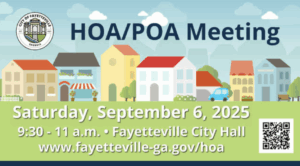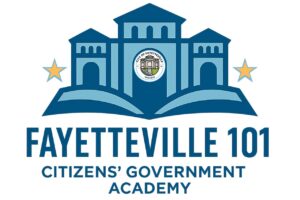Fayetteville City Manager Joe Morton sat down last week for a non-political look back at 2011 and a look ahead at 2012. The look back included a large variety of issues such as transportation, current economic impacts, future concepts and city government functions. The look ahead to 2012 included issues such as transportation, sales taxes and economic development.
The past year has been a busy one in Fayetteville. Perhaps as visible as any change during the year was the February opening of the Olde Courthouse Tavern downtown across from the old courthouse.
“This was a big plus for the city,” Morton said. “It has received good support from the community and has invigorated downtown Fayetteville with a night time presence.”
Downtown vision
There was another event in 2011, one that represents a vision for the future, that makes a statement about the immediate downtown area and what might unfold there in the coming years.
The Fayetteville Downtown Development Authority in February released a concept vision for future growth that extends from Glynn Street downtown to Tiger Trail to the west and includes the entire area between Lanier Avenue and Stonewall Avenue. The concept plan would connect the immediate downtown area to the Villages community to the west.
Morton said concept plans call for a mixed-use development within a highly inter-connected, walkable series of paths and greenspace.
Fayetteville Main Street Director Brian Wismer said the concept for Fayetteville Downtown West originated last year during the annual strategic planning meeting of the city’s Downtown Development Authority and Main Street organizations and was devised in conjunction with Peachtree City-based Historical Concepts. The concept plan was presented to the City Council during its March retreat.
As conceived, the 9.1-acre area that is positioned between Stonewall Avenue to the south and Lanier Avenue to the north stretches from the commercial area along Glynn Street westward to Tiger Trail and would contain a mixture of commercial and residential space along with 5.4 acres of open space and greenspace.
The older homes would stay in place and compliment the new construction designed to fit seamlessly into the area, Wismer said. As proposed, the development’s five phases would allow for five cut-through streets in addition to Bennett Street which would be widened, Wismer said, adding that new curb cuts would not be needed for the development since a sufficient number of those already exist.
“Realistically, and given the recession, it could take 20 years to complete,” said Wismer. “This is a development vision with no time frame attached, one that provides a way to stretch the downtown core where people can live, work and visit.”
Sidewalks and funding
Transportation projects were significant in 2011. The Grady Avenue/Beauregard Avenue roundabout was completed during the summer and turned many naysayers into supporters, Morton said.
Also completed was the South Jeff Davis sidewalk project that extended from Bonnie Lane to South Jeff Davis. The project ties the downtown area to Helen Sams Parkway, Morton said. And the sidewalk projects on Hood Avenue, White Road and Forrest Avenue were completed, providing connections between residential and commercial areas and schools.
The motivation behind accepting the federal money for the sidewalk project was simple, said Morton. The city could accept the money designated significantly for that purpose or not have the sidewalks and hope that local money would be available sometime in the future.
Two other transportation projects saw significant progress in 2011 and will be more obvious in the next year or two.
One is the Hospital Area Paths and Crosswalk project that received state and federal funding that will improve pedestrian access on Ga. Highway 54 West at Piedmont Fayette Hospital and across the street to the Togwotee commercial development and on to Lester Road.
It may take some time before construction can begin, but once completed, the area will have an enhanced crosswalk on Hwy. 54 at the hospital and 8,500 feet of multi-use paths extending through the Togwotee Village retail area across from the hospital, effectively linking it with additional multi-use paths to be constructed in the area of Lester Road to the south.
Hwy. 92 realignment
And in what is the most important road project in Fayetteville in years, the city earlier this year worked out the agreements with the Hudson Plaza owner and the Georgia Dept. of Transportation that paves the way for the Hood Avenue/Ga. Highway 92 realignment.
The Hwy. 92/Hood Avenue/Jeff Davis Connector project will essentially serve as the city’s northside connector. The $7.9 million project funded by SPLOST (Special Purpose Local Option Sales Tax) dollars was previously approved by the Fayette County Commission. The project is also listed on the regional TSPLOST list that will go up before voters next year. Either way, the funds for the project are in place.
Project plans call for moving the traffic signal from Hwy. 92 a short distance south to the intersection with Hood Avenue. West on Hood Avenue just a short distance from North Glynn would be the location of a roundabout that would funnel traffic northeast and northwest onto Hwy. 92.
Motorists at the new traffic signal at Hood Avenue would be able to continue across the intersection on what is proposed to be an extension of Kathi Avenue that would, via another roundabout, link with North Jeff Davis.
Also connected to transportation is a new Fayetteville Gateway sign currently under construction on Hwy. 54 West as it splits into Stonewall Avenue and Lanier Avenue. Morton said the design incorporates the look of the neighboring Main Street building and the Fayetteville Cemetery gates.
Morton in the look-back over the year also noted a variety of other accomplishments connected to a number of city departments and operations.
24-hour license turnaround
One of those involved a review and subsequent changes to the city’s permitting and business license process aimed at assisting local businesses.
“We can usually turn around a business license within 24 hours,” Morton said.
Pertaining to public safety, Morton said the police department purchased and began implementation of a new records management/mobile data system that will allow better communication electronically between the department and other county agencies.
Morton said the police department also completed several seminars with local businesses that had experienced robberies and had cleared a series of air conditioner thefts by arresting the two people responsible.
A partnership between Fayetteville Main Street and the Fayette Shrine Club brought the Downtown Chili Fest to the old courthouse lawn in October, Morton said. The first-time event included 30 participants and 1,000 attendees. And Main Street during the growing season also launched a program that brings local produce growers to the downtown area, Morton added.
Improved communications
On issues pertaining to government functions, Morton said the city is successfully using social media such as Facebook and the city website to provide information and to interact with the community.
Morton said city staff also collaborated with local jurisdictions to develop and approve a revised Consolidated Communications intergovernmental agreement. The new agreement established a 911 tax district to supplant the jurisdictional contributions required to supplement the 911 user fee, thus providing a more equitable cost-sharing methodology to operate the 911 center, said Morton.
Another accomplishment dealt with the collaboration between the city’s fire and police departments to develop a Request for Proposal and select a new computer-aided dispatch system for Fayette County 911.
The city fire department also completed new training requirements associated with its continued compliance with the National Incident Management System, Morton said.
And the city continued to advance the employee wellness program by including biometric testing that helps employees work on individual goals and encourages and rewards healthy standards.
Wells & bonds
Pertaining to water and wastewater, Morton said the city in 2011 renewed its groundwater permit that maintains the current 4 million gallons per day capacity, modified the wastewater discharge permit to handle 5 million gallons per day and continued participation with the North Metro Water District toilet rebate program.
In city finances, the Downtown Development Authority 2001 bond for the Villages Amphitheater was refinanced with a resulting savings of $140,000. Morton said the city also earned the Government Finance Officers Comprehensive Annual Financial Report award for the 15th consecutive year and earned the Government Finance Officers Budget award for the fifth consecutive year.
Addressing a look forward to 2012, Morton noted upcoming issues related to transportation, sales taxes, the sign ordinance, a false alarm ordinance and economic development.
Perhaps as significant as anything aside from the economy will be the ongoing efforts on the Hwy. 92/Hood Avenue/Jeff Davis Connector project. Morton said right-of-way acquisition and design work is expected to be completed next year, adding that the Georgia Dept. of Transportation is ready to go on the project. Morton said construction is expected to begin in 2013.
The budget will continue to be important next year given the realities of the local economy, Morton said, adding that countywide renegotiations on Local Option Sales Tax proceeds will need to be completed by the end of next year.
“We’re still dealing with the economy so the budget is going to be a big challenge,” Morton said.
Morton said city staff were given direction by the council earlier this year to review the sign ordinance and possible changes to some of the variance issues. He expects a committee to be formed that includes a council representative to study any proposed changes. The council has previously relaxed the conditions pertaining to walking signs and signage in the downtown area.
Originally proposed in 2011 but postponed until the new council is seated, the City Council will take up the issue of a False Alarm Ordinance, Morton said.
Redevelopment authority
There will be at least two issues under scrutiny next year that apply to economic development. One will be the continuing challenge of the years-long recession and its consequences on sales and property taxes and business development.
Another economic development issue expected to come up for consideration is a Redevelopment Authority Powers referendum that would target older commercial areas. Morton said the council will take up the issue and determine a process aimed at garnering public support for the referendum. The final date for the referendum is November 2012, Morton said.
The city attempted to accomplish a similar infill development initiative a couple of years ago through a vehicle referred to as a TAD (Tax Allocation District). The three target areas included the old 692 Shopping Center on North Glynn Street, the Fayette Place Shopping Center on North Glynn and, potentially, the under-utilized area of the Market Place at Lafayette that is a part of the Villages at Lafayette master plan.
The vote came at a time when virtually no referendum with the term “tax” in it would pass public muster. Many voters might have ben unaware that, had it passed, the resulting initiatives would have not raised their taxes but would have designated that the property taxes in the defined target area or areas be frozen for a period of time.
Financing for the initiative comes as the tax base for the project area is frozen to form a base valuation, with property taxes used to pay eligible infrastructure-affiliated redevelopment costs. Bonds may also be issued to help finance projects. Subsequent annual tax revenues in the project area are used to fund the city’s portion of the redevelopment.
And finally, Morton said there will be a number of important issues presented at the annual City Council retreat expected to be held in February or March.












Leave a Comment
You must be logged in to post a comment.